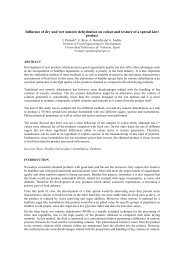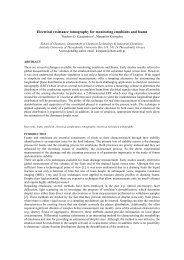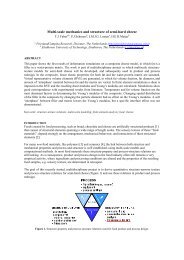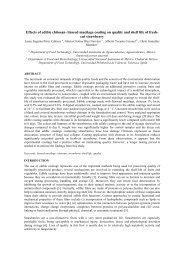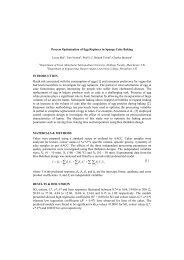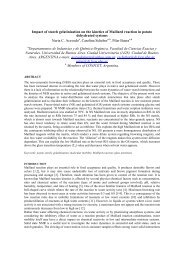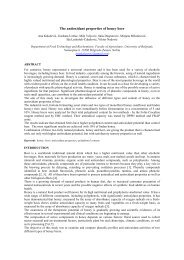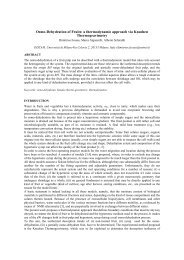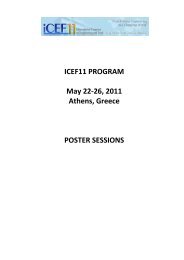Kinetics of Amycolatopsis mediterranei DSM 43304 lipase-mediated ...
Kinetics of Amycolatopsis mediterranei DSM 43304 lipase-mediated ...
Kinetics of Amycolatopsis mediterranei DSM 43304 lipase-mediated ...
Create successful ePaper yourself
Turn your PDF publications into a flip-book with our unique Google optimized e-Paper software.
sufficient to cause denaturation <strong>of</strong> the enzyme molecule [20]. The present results are consistent with the<br />
reported inhibition <strong>of</strong> <strong>lipase</strong>s by acetic acid during synthesis <strong>of</strong> esters [7, 21].<br />
Water can have a dramatic influence on biocatalytic processes in non-aqueous media, depending upon the<br />
nature <strong>of</strong> the organic solvent used as a suspension medium [22, 23] and the form <strong>of</strong> enzyme protein<br />
employed [24]. Several mechanisms have been proposed for water-induced enzyme activation in nonaqueous<br />
milieu. It may act as a molecular lubricant, increasing internal flexibility <strong>of</strong> the enzyme [25]<br />
reducing unfavourable protein-protein interactions, responsible for structural distortions and aggregation or it<br />
may increase the active site polarity [23, 24] leading to enhanced enzyme activity in non-aqueous solvents. In<br />
the present study, the initial rate and equilibrium conversion were highest when 100 µL <strong>of</strong> water (1%, v/v)<br />
was added to the reaction mixture under otherwise similar conditions. Water accumulation during the<br />
esterification reaction possibly caused a decrease in the initial rate and equilibrium conversion, when the<br />
amount <strong>of</strong> initially added water was more than 100 µL. Thus, due to its effect on the thermodynamic balance<br />
<strong>of</strong> the reaction, an amount <strong>of</strong> water more than an optimum value (100 µL) resulted in decreased initial rates<br />
and equilibrium conversion indicating that hydrolysis outweighed synthesis (esterification).<br />
Reaction temperature has a pr<strong>of</strong>ound effect on reaction rates, equilibrium conversion and enzyme stability<br />
[19, 26]. However, the effect <strong>of</strong> temperature on equilibrium conversion and initial rate is difficult to predict<br />
because it may influence the reaction efficiency depending on the source <strong>of</strong> the enzyme [26, 27], type <strong>of</strong><br />
immobilization [26] and ionization state <strong>of</strong> the enzyme active site [28]. In accordance with transition state<br />
theory, increasing temperature would result in a positive effect on the rate constant; however, high<br />
temperatures may disrupt enzyme tertiary structure resulting in loss <strong>of</strong> catalytic activity [5]. Therefore, in<br />
view <strong>of</strong> the fact that at temperatures ≥60 °C the immobilized enzyme inactivates faster over the time period<br />
<strong>of</strong> the reaction (72 h) and the boiling point <strong>of</strong> the reaction mixture occurred at 69 °C, the influence <strong>of</strong> the<br />
temperature on the reaction kinetics was investigated in the temperature range <strong>of</strong> 30 to 50 °C. Since Celiteimmobilized<br />
A. <strong>mediterranei</strong> <strong>DSM</strong> <strong>43304</strong> <strong>lipase</strong> is thermostable, ester synthesis was observed at all<br />
temperatures from 30 to 50 °C and the initial rates and equilibrium conversions were found to increase with<br />
the temperature with a maximum rate and equilibrium conversion obtained at 50 °C. This suggests the<br />
predominance <strong>of</strong> kinetic effect in this temperature range [5, 17].<br />
Esterification using optimal parameters<br />
A sequential strategy <strong>of</strong> experimental design proved to be useful in determining the conditions for<br />
maximizing the equilibrium conversion in n-hexane using Celite-immobilized A. <strong>mediterranei</strong> <strong>DSM</strong> <strong>43304</strong><br />
<strong>lipase</strong> as a catalyst. Optimum conversion was obtained at an acetic acid/isoamyl alcohol molar ratio <strong>of</strong> 2,<br />
initial addition <strong>of</strong> 1% (v/v) <strong>of</strong> water and 7.5% (w/v) <strong>of</strong> enzyme (i.e. 2.5 g <strong>of</strong> enzyme mol -1 <strong>of</strong> alcohol) at 50<br />
°C. Under these conditions, a 12 h reaction time was sufficient to reach the equilibrium molar conversion <strong>of</strong><br />
59%; however under non-optimized operational conditions the equilibrium molar conversion reached was<br />
21% after 36 h <strong>of</strong> reaction time (Figure 1). Widely different conversion yields <strong>of</strong> isoamyl acetate in organic<br />
solvent systems have been reported in the literature. Hari Krishna et al. [29] used n- heptane for the synthesis<br />
<strong>of</strong> isoamyl acetate and obtained a conversion yield <strong>of</strong> >80% in 72 h using Rhizomucor miehei Lipozyme IM-<br />
20 at 6.7 g mol -1 <strong>of</strong> substrate, whereas a maximum conversion yield <strong>of</strong> 100% was reported by Romero et al.<br />
[5] using Candida antarctica Novozyme 435 at 13.8 g mol -1 <strong>of</strong> substrate in n-hexane. Liaquat and Owusu<br />
Apenten [30] used n-hexane during esterification to obtain a conversion yield <strong>of</strong> 30% in 48 h with rapeseed<br />
seedling <strong>lipase</strong> at 200 g mol -1 <strong>of</strong> substrate. Furthermore, Larios et al. [31] reported a conversion yield <strong>of</strong> 74%<br />
for the synthesis <strong>of</strong> n-butyl acetate in n-hexane using C. antarctica <strong>lipase</strong> B at 50 g mol -1 <strong>of</strong> substrate. In the<br />
present investigation a non-commercial Celite-immobilized <strong>lipase</strong> at 2.5 g mol -1 <strong>of</strong> substrate was employed to<br />
achieve a conversion yield <strong>of</strong> 59% in 12 h, indicating a significant esterification at a lower enzyme<br />
concentration.<br />
Kinetic model based on time-course measurements<br />
Several studies have reported the kinetic modeling <strong>of</strong> <strong>lipase</strong> <strong>mediated</strong> esterification [10, 12, 32] and transesterification<br />
[17, 33, 34] reactions in organic media using commercially available immobilized <strong>lipase</strong>s.<br />
However no attempt has been made to develop a kinetic model for the direct esterification using a noncommercial<br />
<strong>lipase</strong>. To the best <strong>of</strong> our knowledge the present study is the first report on the development <strong>of</strong> a<br />
kinetic model for direct esterification reaction in organic solvent catalyzed by a non-commercial<br />
actinomycete <strong>lipase</strong>. Esterification reactions <strong>of</strong> various organic acids with different alcohols by a variety <strong>of</strong><br />
commercial <strong>lipase</strong>s are <strong>of</strong>ten modeled using the so called Ping Pong Bi Bi mechanism, a well known and<br />
widely accepted mechanism for <strong>lipase</strong>-catalyzed reactions [9-11, 17]. In the present investigation, the Ping<br />
Pong Bi Bi mechanism coupled with a competitive inhibition by one <strong>of</strong> the substrates was assumed as a basis



